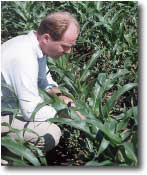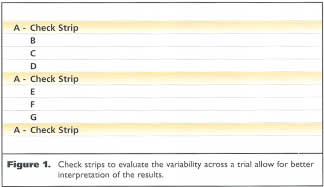
On-Farm Field Trials - Plot Protocol
 For
years, corn producers have been participating in (or conducting) field trials
to provide information that would make production practices more sustainable
and profitable. In some cases, farmers have worked with university or government
personnel to establish complex, replicated experiments. In a large number
of situations, strip trials have been established. Generally these strip trials
are simple, field length strips. As well, they are unreplicated that is, each
variety, fertilizer, etc., appears only once in the trial.
For
years, corn producers have been participating in (or conducting) field trials
to provide information that would make production practices more sustainable
and profitable. In some cases, farmers have worked with university or government
personnel to establish complex, replicated experiments. In a large number
of situations, strip trials have been established. Generally these strip trials
are simple, field length strips. As well, they are unreplicated that is, each
variety, fertilizer, etc., appears only once in the trial.
Controversy has existed for years over these two approaches to gathering information.
Those with a leaning towards scientific research reject the notion of plots
not replicated. They claim you have no way of telling whether the yields are
a result of position within the field (e.g., down the strip that received
extra manure two years ago) or the actual treatment imposed. Replication within
the fields is the only way to have confidence in the results, they say.
On the other hand, small, replicated plot research has often been criticized
for relying on plots that are not representative of normal field conditions.
In addition, small plot research has generally been conducted in a very small
number of locations, and so the adaptability of the results to other environments
has been questioned. Field length strips unreplicated, but conducted across
many environments is the only way to have confidence in the results, according
to replicated plot research critics.
Fortunately, the marrying of these two positions is possible when we consider
a few basic ideas.
 Variability
Variability
In-field variability should be a concern to all those involved in gathering
crop production information. Replication can often be unmanageable and time
consuming. A reasonable alternative to replication is planting a check strip
down the left, centre and right side of each trial. In a hybrid trial these
check strips would, of course, be planted with the same hybrid. As the results
are obtained from each strip, producers can simply evaluate the variability
within the check strips. If these three yields are relatively close - within
10 to 15 per cent of each other - then we can have some confidence the data
will contribute to our understanding. If the check strips yields vary greatly,
the results for the entire test have little value and should be discarded.
Replication
A friend tells you he is sure the cashier has just handed him a two-headed
coin, but he won't allow you to look at it. He decides to flip the coin repeatedly
and challenges you stop him when you are 100 per cent confident that it is,
in fact, a two-headed coin. After two or three flips (all heads), you realize
it is still quite possible that chance alone has produced the result. However,
after some number of replications (5, 10, 15, etc.), you become confident
it is two-headed, even though you realize there is still an outside possibility
that it's a normal coin. Replication is necessary to have confidence in test
results. In some research, this replication occurs at specific sites with
many small plots. In strip trials, it is often accomplished by having a large
number of sites.
Interpretation
of results
Variety selection is most
suited to unreplicated strip trials. It is generally easiest to generate a
large number of variety strip trials (replication) and in most cases, little
other information is gathered beyond yield data. Our goal is to pick a winner;
we are somewhat less concerned about why it won. However, if we are interested
in comparing two types of fertilizer, things change considerably. First, it
generally becomes more difficult to find co-operators for these types of projects,
so our total data base gets smaller and we need to consider replicating at
each site to build confidence in the results. As well, if accurate soil tests
are not taken from each strip, it becomes difficult to interpret the results
and predict when a grower might expect a yield advantage for Fertilizer A
over Fertilizer B.
Hybrid Selection
In Ontario, the Ontario Corn
Committee conducts small-plot research to evaluate hybrid performance. The
value of these performance trials lies in the fact that they are replicated,
field variability is carefully assessed and the vast majority of available
hybrids for a particular heat unit rating are present in the same test. The
main weakness of these trials is that a range of hybrids is only tested at
three or four locations. So while we may be confident that a certain number
of hybrids are superior at these particular sites, we have considerably less
confidence in deciding whether Hybrid A will outyield Hybrid B across a wide
range of environments.
In variety strip trials, these head-to-head comparisons can be made with greater
confidence, provided that a large number of trials actually have the two hybrids
present that you want to compare. In the past decade, seed companies have
been big promoters of this type of analysis. Recently, the Ontario Soil and
Crop Improvement Association, with the assistance of Agriculture and Agri-Food
Canada, launched its Ontario Field Trials Online, where strip trials conducted
by farm co-operators from across the province can be entered into a common
data base. The potential is excellent for this data base to complement the
performance trials and to assist in hybrid selection.
The process of making better decisions begins now as you plan your on-farm
trials for 2000.